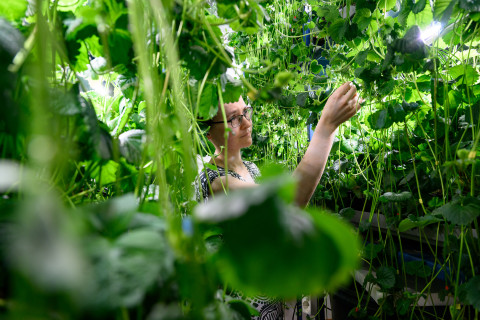The University of Eastern Finland has years of experience in research addressing the cultivation of strawberries. The latest cultivation experiments show that strawberries can be grown cost-effectively and self-sufficiently, even from seeds.
Several strawberry cultivation experiments are currently underway at the Department of Environmental and Biological Sciences on the Kuopio Campus, with researchers testing different growing mediums and irrigation methods, as well as the production of runners and seedlings.
“It is possible to grow strawberries efficiently – anywhere and all year round,” Researcher Harri Kokko says.
“This does not necessarily require access to land, as strawberries can be grown in vertically stacked layers efficiently and, most importantly, hygienically, even in small indoor spaces.”

“Strawberry cultivation becomes self-sufficient when a farmer can grow new plantlets from the runners of mother plants. Cost savings can also be found in growing mediums.”
“We have experimented with the production of strawberry runners in six different growing mediums, including moss and wood fibre. We need to find an alternative to peat.”
“In our runner experiment, we are growing 216 mother plants in 60-day intervals. Everything has worked well, and a large number of runners have grown. Each mother plant has produced around 20 daughter plants,” Postdoctoral Researcher Anna Toljamo says.
The cultivation experiment also compares three different irrigation systems. In hydroponic cultivation, or hydroponics, very little growing medium is needed, as plants mainly grow in a nutrient solution. This method of cultivation has traditionally been used for growing lettuce and herbs, but now it is being tested for strawberry cultivation as well.
“Gutter cultivation also seems to be working well, which is a bit of a surprise,” Toljamo notes.
“In hydroponic cultivation, the nutrient solution can be recycled, so nutrients don’t go to waste.”

Strawberry plant cultivation gets significantly faster
When strawberry runners are grown under LED light, the length of the day is 20 hours, which prevents the plants from flowering.
In a greenhouse on the rooftop of the Snellmania building, strawberries are currently growing almost under the midnight sun. Pollination of the flowers is being taken care of by bumblebees that have a hive in the greenhouse.
“The strawberry variety F1-Soraya tested in our pilot experiments is suitable for continuous growing in a greenhouse. So far, there isn’t much research into seed cultivation and continuous yield varieties being done elsewhere,” Kokko notes.
It takes three months for a strawberry plant grown from seed to flower.
Harri Kokko
Researcher
“The plants are healthy – they do not carry plant diseases or pests for that matter,” Kokko adds.
When growing strawberries indoors, even the propagation of strawberry runners can be accelerated. Plug plants produced from runners are ready for planting already in the spring – and not in July as with the traditional cultivation methods.


